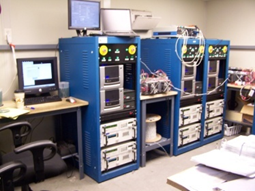Oct
27
Results of Battery Dissection At Death
October 27, 2010 | 5 Comments
That’s a morbid headline, but that’s what Ohio State University researchers are reporting at the AVS 57th International Symposium & Exhibition, that took place last week at the Albuquerque Convention Center in New Mexico. The lab’s results suggest that the irreversible changes inside a dead battery start at the nanoscale. An ongoing experiment at OSU is studying why batteries lose their ability to hold a charge as they age -specifically lithium-ion batteries, which are at the top of research lists for their potential to power the electric cars of the future.
Yann Guezennec and Giorgio Rizzoni of OSU developed new experimental facilities and procedures to charge and discharge commercially-available Li-ion batteries thousands of times over many months in a variety of conditions designed to mimic how these batteries are actually used by hybrid and all-electric vehicles. Some of the batteries were run in hot temperatures like those in Arizona; others in colder conditions similar to those in Alaska.
The OSU team has given considerable thought to the time used for cycling life and the environment that batteries will endure. What’s missing is variation say from 6 months of sub zero temps to sweltering for 6 months in alternative periods and long periods of inactivity. Nothing is perfect, and the real world will offer new test scenarios with every user. But science has to start somewhere and this is the best start yet.
To understand the results of this testing, Bharat Bhushan, Suresh Babu, and Lei Raymond Cao studied the materials inside of the batteries to help determine how this aging manifests itself in the structure of the electrode materials.
When the sample batteries died, the scientists performed a forensic dissection of them and used a technique called infrared thermal imaging to search for problem areas in each electrode, a 1.5-meter-long strip of metal tape coated with oxide and rolled up like a jelly roll. They then took a closer look at these problem areas using a variety of techniques with different length scale resolutions (e.g. scanning electron microscopy, atomic force microscope, scanning spreading resistance microscopy, Kelvin probe microscopy, transmission electron microscopy) and discovered that the finely-structured nanomaterials on these electrodes that allow the battery rapidly charge and discharge had coarsened in size. One might fairly expect that ‘coarser’ means larger and rougher surfaces.
More important information came from additional studies of the aged batteries, using neutron depth profiling, that revealed that a fraction of the lithium that is responsible, in ion form, for shuttling electric charge between electrodes during charging and discharging, was no longer available for charge transfer, but was irreversibly lost from the cathode to the anode. Reduced lithium electrolyte getting locked into the anode equals certain death.
Rizzoni, director of the Center for Automotive Research at OSU said, “We can clearly see that an aged sample versus and unaged sample has much lower lithium concentration in the cathode. It has essentially combined with anode material in an irreversible way.”
Just what ‘irreversible’ means is yet to be determined, leaving the question would the lithium remain lost in a metallurgical refining recycling operation as well? That would come as quite a shock; this writer surmises that a full anode destruction and lithium recovery program could recycle the lithium for reuse in a new battery.
The greater question is lengthening the battery life by reduction or elimination of the anode ‘coarsening’ effect. The OSU researchers suspect, but cannot yet prove, that the coarsening of the cathode may be behind this loss of lithium. If this theory turns out to be correct, it could point battery manufacturers in the right direction for making durable batteries with longer lifetimes.
Storing electrons for ready release in a battery is improving fast after more than a century of little commercial scale progress. Lithium-ion is a superb chemistry for batteries but the life expectancy versus cost has to improve for a real deep vehicle fleet change to occur.
This writer thinks the sophistication will get there. Battery lifetimes could get very long very quickly with good forensic information now coming out.
The OSU effort is quite valuable work. Let encourage an even broader array of tests to offer results for the maximum potential innovation.
Comments
5 Comments so far



I guess if they are stress testing Lithium batteries – they better be using a fireproof lab!
nice post. thanks.
Generally, advance in battery science is as important as is the advance in electric autos, wind farms and other green technologies
Intriguing post. I have been searching for some good resources for solar panels and discovered your blog. Planning to bookmark this one!
Awesome post. I so good to see someone taking the time to share this information